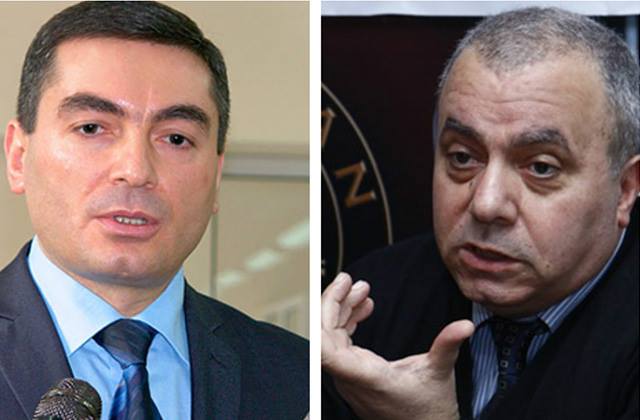
The Tax Code of 90 Billion

The draft Tax Code was debated at NA extraordinary session the day before. Many questions were posed to the speaker Vakhtang Mirumyan, deputy head of State Revenue Committee (SRC), however, the most noteworthy was one posed by Hrant Bagratyan, and the answer, which followed it.
H.Bagratyan stated that in the draft Tax Code he observed increase of taxes in 6 directions, and on the whole, it comprises about AMD 40 billion. Enumerating those directions (taxation of shares and dividends, increase in excise tax for petrol and cigarette and etc.), Bagratyan directed a question, “I want you to show did the draft pass and expertise in any of the directions? Did you count how much the budget for 2015 will comprise if this taxation mechanism were applied since last year?”
V.Mirumyan’s reply was, “If that all was implemented in 2015, positive influence on incomes would comprise 1.8 pp of GDP as of 2015.” Then he quickly passed on to the next question. However, this was the most crucial and curious reply regarding both formulations and content. In his question Bagratyan highlights the expression “increase of taxes” and SRC deputy head “positive influence on incomes.” They are the same, simply “increase of taxes” is an expression not pleasant to the ear, and brings unpleasant associations among the society/business. That’s why the authorities (not only of Armenia) strive to miss that word. In short, when SRC deputy head touched upon “positive influence on incomes” this means taxes will grow.
It’s worth touching upon the content next: how much will the tax burden increase? Note, here Bagratyan mentions an exact figure (AMD 40 billion), and SRC deputy head prefers to introduce the difference in GDP percentage. Why? Of course, while touching upon taxes and their change in economy, it’s more proper to speak by percentage. However, volume of the amount is not of less importance. When 1.8% GDP is being touched upon and a quick shift is being made to the next question, many may not fix its seriousness. However, when it’s turned into money, a rather big number is observed—AMD 90.8 billion, which already attaches attention.
Thus, in 2015 Armenia’s GDP comprised AMD 5 trillion 47.5 billion. Its 1.8% comprises AMD 90.8 billion. This means, if the Tax Code was valid in 2015, then in form of taxes it would be collected by AMD 90.8 billion or by 8.5% more than it has actually been collected (in 2015 the state budget recorded AMD trillion 67.9 billion tax revenue). This is 2.2 times more from the 40 billion mentioned by Bagratyan. AMD 90 billion additional tax is being provided only on account of change of legislation. To express more simply, tax burden is becoming heavier.
And this, of course, can’t be positively accepted by the society and the business. This assessment of “positive influence on incomes” or increase of tax burden, basically, was the most sincere confession by the representative of economic bloc. Prior to that, when criticism was heard that the Tax Code doesn’t contribute to the development of economy, but was preventing it, respective bodies disagreed, saying it was a document based on balance model.
“Liberalizations in the whole field are planned to make the field more attractive, and naturally, on account of it, loss is offered to reimburse on account of other factors, i.e. it should be observed in the balance model, and not say this is good, we have nothing to say, but—this is bad, and complain of it. It should be observed in the whole context,” Vakhtang Mirumyan said replying to the question by the journalist of “168 Hours.”
And now, while observing by total context, we may fix that tax burden is increasing by 1.8% of GDP or 8.5% of tax revenues. Or by AMD 90 billion. AMD 90 billion is rather a big figure, that’s why SRC deputy head prefers not to mention it. Of course, great mathematical skills are not necessary to turn the percent into a figure, however, firstly, a considerable number of MPs don’t know how much the GDP comprised in 2015, secondly, if known, they’d hardly manage to do calculations during the short Q&A session, and thirdly, if calculated they wouldn’t manage to speak of it prior to voting.
So it went. Bagratyan in his reply touched upon taxation of VAT and dividends, and then stated on increase of tax burden, however, his time was up.
One of the noteworthy points was that this draft is being consistently pushed forward not mainly by Armenia’s authorities, but international financial organizations (e.g. International Monetary Fund), which allocated large loans to our country. These loans should be served and it’s becoming heavier (grace period is about to end).
To provide even heavier service of loans it’s necessary to provide growth of tax revenues. And taxes grow under the influence of a few factors: due to economic growth (increase of taxation base), fight against shadow (or toughening of administration) or legislative change (of increase of rates).
The Government states that it highlights economic growth and fight against shadow, however, as it may be observed, both the Government and international instances hope on the last factor—increasing tax burden. And for this very reason “debtors,” toughening the administration, do their best, so that the draft was approved, to provide return of their money. It sounds like conspiracy theory, however, there is no any other logical explanation.
And the strangest will be the fact, if the parliamentary majority comprised of businessmen-MPs voted for the draft. We say “if” as in Parliaments led by logic those introducing interests of businessmen don’t vote for the drafts, which make their tax burden even heavier.
In our country, however, this logic lacks, as actual voting results are not available, at least there is 1% possibility that the Tax Code won’t be approved by first hearing.
By Babken Tunyan























